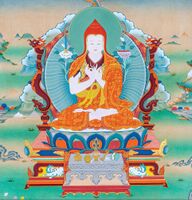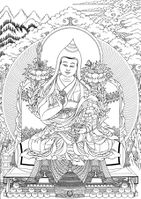Mi pham rgya mtsho: Difference between revisions
No edit summary |
No edit summary |
||
| (One intermediate revision by the same user not shown) | |||
| Line 1: | Line 1: | ||
{{Person | {{Person | ||
|StudentOf='jam dbyangs mkhyen brtse'i dbang po; 'jam mgon kong sprul; Dpal sprul rin po che; Lung rtogs bstan pa'i nyi ma; Dzogchen Drubwang, 4th | |||
|TeacherOf=A 'dzoms 'brug pa 'gro 'dul dpa' bo rdo rje; Las rab gling pa; Dodrupchen, 3rd; Zhechen Gyaltsab, 4th; Lung rtogs bstan pa'i nyi ma; Pad+ma dbang mchog rgyal po; Kun bzang dpal ldan; Khyentse, Dilgo | |||
|ReligiousAffiliation=Nyingma | |||
|MainNamePhon=Mipam Gyatso | |MainNamePhon=Mipam Gyatso | ||
|MainNameTib=མི་ཕམ་རྒྱ་མཚོ་ | |MainNameTib=མི་ཕམ་རྒྱ་མཚོ་ | ||
| Line 25: | Line 28: | ||
|TibDateAnimal=Horse | |TibDateAnimal=Horse | ||
|TibDateRabjung=14 | |TibDateRabjung=14 | ||
|PosBuNayDefProv=Definitive | |PosBuNayDefProv=Definitive | ||
|BuNayDefProvComplex=No | |BuNayDefProvComplex=No | ||
Latest revision as of 14:15, 10 February 2023
| PersonType | Category:Classical Tibetan Authors |
|---|---|
| MainNamePhon | Mipam Gyatso |
| MainNameTib | མི་ཕམ་རྒྱ་མཚོ་ |
| MainNameWylie | mi pham rgya mtsho |
| AltNamesTib | མི་ཕམ་འཇམ་དབྱངས་རྣམ་རྒྱལ་རྒྱ་མཚོ་ · འཇམ་དཔལ་དགྱེས་པའི་རྡོ་རྗེ་ · འཇུ་མི་ཕམ་ |
| AltNamesWylie | mi pham 'jam dbyangs rnam rgyal rgya mtsho · 'jam dpal dgyes pa'i rdo rje · 'ju mi pham |
| AltNamesOther | mipham |
| YearBirth | 1846 |
| YearDeath | 1912 |
| BornIn | sde dge |
| TibDateGender | Male |
| TibDateElement | Fire |
| TibDateAnimal | Horse |
| TibDateRabjung | 14 |
| ReligiousAffiliation | Nyingma |
| StudentOf | Jamyang Khyentse Wangpo · Jamgön Kongtrul Lodrö Taye · Patrul Rinpoche · Nyoshul Lungtok Tenpai Nyima · Fourth Dzogchen Drubwang Mingyur Namkhai Dorje |
| TeacherOf | Adzom Drukpa Drodul Pawo Dorje · Lerab Lingpa · The Third Dodrupchen Jigme Tenpai Nyima · The Fourth Shechen Gyaltsap Gyurme Pema Namgyal · Nyoshul Lungtok Tenpai Nyima · Pad+ma dbang mchog rgyal po · Kunzang Palden · Dilgo Khyentse Tashi Paljor |
| BDRC | https://www.tbrc.org/#!rid=P252 |
| Treasury of Lives | http://treasuryoflives.org/biographies/view/Mipam-Gyatso/4228 |
| IsInGyatsa | No |
| PosBuNayDefProv | Definitive |
| PosBuNayDefProvNotes | "Mipam explains that the last wheel’s status as the definitive meaning does not refer to everything taught in the last wheel, but specifically concerns the teaching of Buddha-nature: ...'Although the meaning of the last wheel is praised in the sūtras and commentaries, [this does] not [refer to] everything in the last wheel, but is spoken in this way concerning the definitive meaning position of demonstrating the [Buddha-]nature.' Douglas Duckworth, Mipam on Buddha-Nature, pp. 4-5. |
| PosAllBuddha | Qualified Yes |
| PosAllBuddhaNote | For sentient beings, buddha-nature is present, but not yet manifest. |
| PosAllBuddhaMoreNotes | "The primordial endowment of the qualities of Buddha in sentient beings is a central part of Mipam’s presentation of Buddha-nature. This is an important aspect of his interpretation that he shares in common with the Jonang tradition." Douglas Duckworth, Mipam on Buddha-Nature, p. 97.
|
| PosWheelTurn | Third Turning |
| PosWheelTurnNotes | Buddha-nature is a third wheel teaching, but he holds both third and second to be of definitive meaning and integrates the two as noncontradictory in his presentation of buddha-nature as the unity of emptiness (in the seceond wheel) and appearance (of kayas and wisdoms in the third wheel). Douglas Duckworth, Mipam on Buddha-Nature, pp. 4-5. |
| PosYogaMadhya | Madhyamaka |
| PosZhenRang | Rangtong |
| PosZhenRangNotes | Though his view is nuanced and he at times wrote from both perspectives. Following are some examples of these variations.
"First it is necessary to ascertain the lack of intrinsic nature of all phenomena in accordance with the scriptures of the protector Nāgārjuna; because if this is not known, one will not be able to ascertain the manner that relative [phenomena] are empty from their own side and the manner that the ultimate is empty of what is other. Therefore, one should first ascertain the freedom from constructs which is what is known reflexively." Douglas Duckworth, Mipam on Buddha-Nature, p. 71.
"In the tradition of self-emptiness, since there is only the ultimately nonexistent, an ultimately existing phenomenon is impossible. In the tradition of other-emptiness, what is ultimately nonexistent is the relative, and what is ultimately existent is the ultimate itself. My tradition is clear in the Rapsel Rejoinder, the tradition propounding self-emptiness." Douglas Duckworth, Mipam on Buddha-Nature, p. 74.
"When we consider Mipam’s depiction of emptiness in light of the categories of “self-emptiness” and “other-emptiness,” we can see that according to Khenpo Lodrö Drakpa’s definitions of a proponent of self-emptiness (claiming a non-implicative negation as the consummate ultimate) and other-emptiness (claiming wisdom as not empty of its own essence), Mipam is a proponent of neither self-emptiness nor other-emptiness. However, according to Lochen’s definitions of self-emptiness and other-emptiness, we see how Mipam can be said to be a proponent of both self-emptiness and other-emptiness!"
And, later on,
"It is clear that Mipam defines himself as a proponent of self-emptiness—as one who propounds that there is nothing ultimately existent—in accord with his definition of the term. Douglas Duckworth, Mipam on Buddha-Nature, p. 74. |
| PosEmptyLumin | Tathāgatagarbha as the Unity of Emptiness and Luminosity |
| PosEmptyLuminNotes | Though Mipam clearly presents several different perspectives on this issue:
Self-existing wisdom is simply made manifest; it is not produced by a cause." Douglas Duckworth, Mipam on Buddha-Nature, p. 100.
|
| Other wikis |
If the page does not yet exist on the remote wiki, you can paste the tag |


